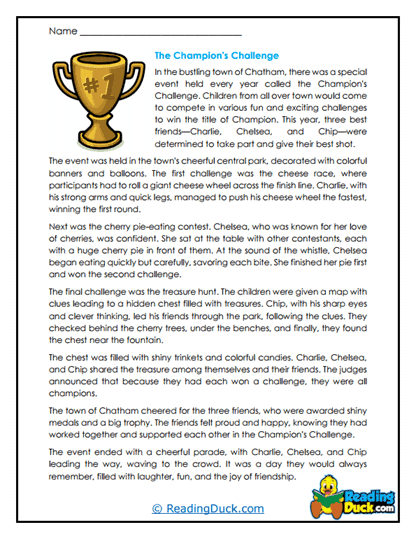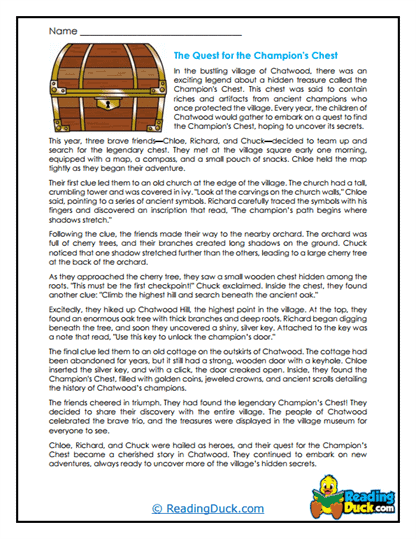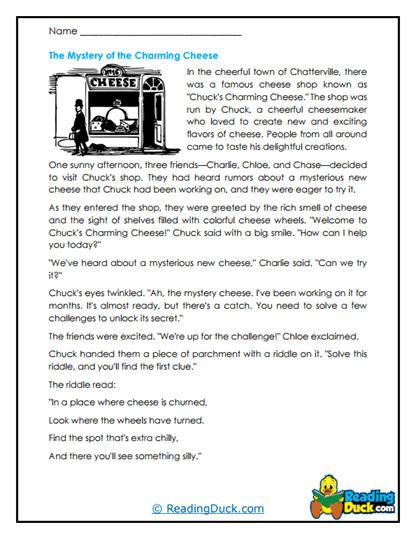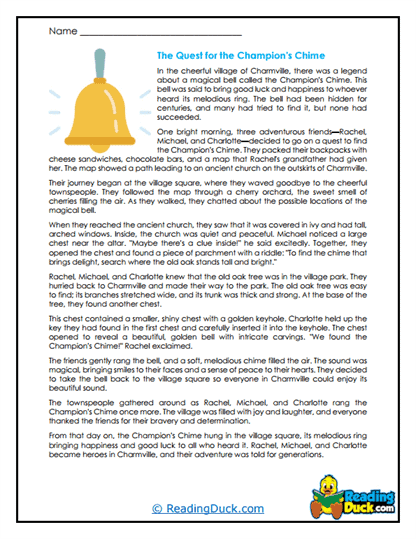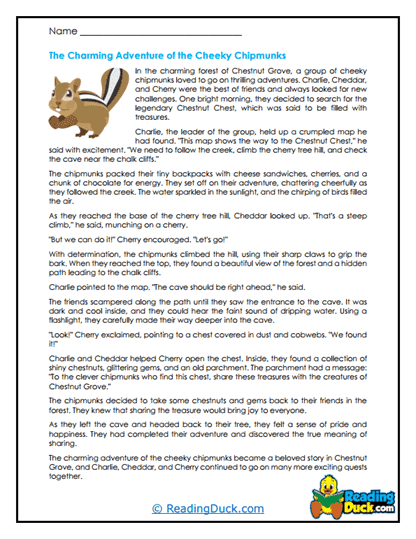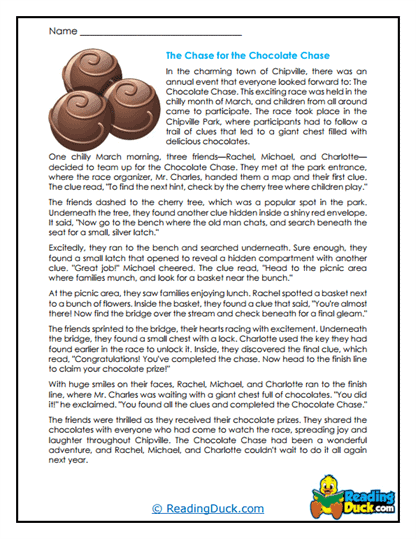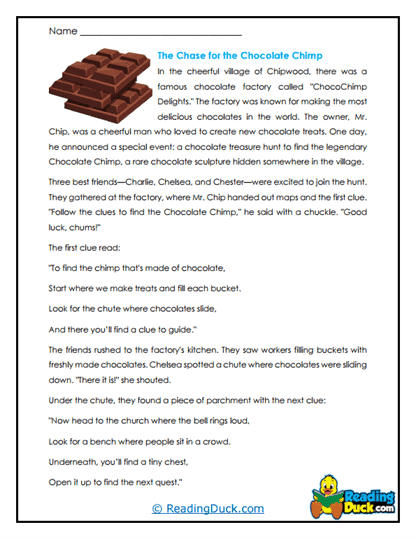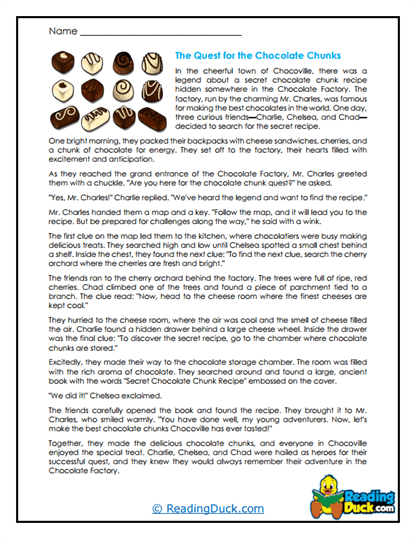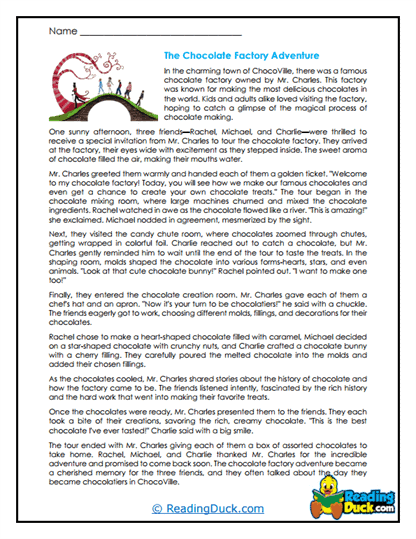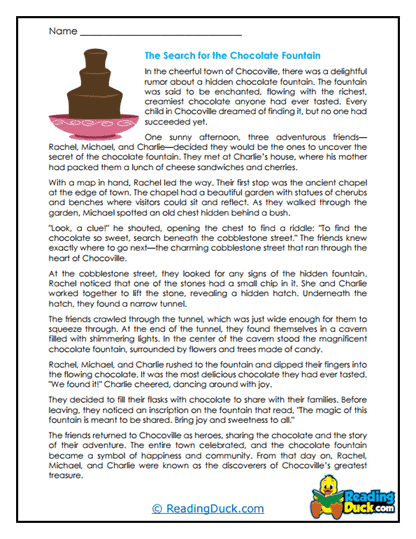Ch- Digraph Reading Passages Worksheets
About Our Ch- Digraph Reading Passages Worksheets
Our collection of Ch- Digraph Reading Passages Worksheets is specifically designed to support students in developing essential phonics skills. These worksheets provide targeted practice with the "ch" digraph, helping young readers become more comfortable with this important sound pattern. Each worksheet features a reading passage paired with a vibrant and engaging picture, drawing students into the content and encouraging them to engage with the material.
In addition to the reading passage, each worksheet includes multiple-choice questions that assess comprehension and ensure that students understand both the passage itself and the phonics concepts being taught. The worksheets are conveniently provided in PDF format, allowing for easy viewing, downloading, and printing. To assist teachers, parents, and tutors, each set also comes with a downloadable answer key, making grading and reference a breeze.
Whether used in classrooms, tutoring sessions, or at home, these worksheets are an excellent tool for building phonemic awareness and reading fluency through focused practice on the “ch” digraph.
Key Features of Our Ch- Digraph Worksheets
- Engaging reading passages featuring the "ch" digraph
- High-quality illustrations accompanying each passage to captivate young readers
- Multiple-choice comprehension questions that reinforce understanding
- Available in easy-to-download PDF format for convenience
- Includes an answer key for simple grading and reference
- Perfect for classroom use, independent practice, or supplemental phonics instruction
Understanding Ch- Digraph Words and the Role of Digraphs in Reading Development
The "ch" digraph is a combination of two letters—'c' and 'h'—that together produce a unique sound, distinct from the individual sounds of the letters. In the case of the "ch" digraph, the two letters often produce a /ch/ sound, as in words like “chair,” “chicken,” or “chop.” Understanding digraphs like "ch" is crucial for early readers because it allows them to move beyond the simple, individual letter sounds they’ve already learned and begin recognizing patterns of letters that create new sounds.
A digraph is when two letters are joined together to make one sound, and they are a key building block in phonics instruction. Besides the "ch" digraph, other common consonant digraphs include "sh," "th," "wh," and "ph." Each of these creates a unique sound that students must learn to recognize and apply when reading. The ability to decode these letter combinations correctly is essential for developing strong reading skills.
The Importance of Mastering the "Ch" Digraph
Mastering the "ch" digraph, along with other digraphs, is an essential step in the journey toward becoming a fluent reader. The reason digraphs like "ch" are so important is that they frequently appear in English. Students who can quickly and accurately decode "ch" digraphs in words are better able to read more smoothly and comprehend what they’re reading. This skill is particularly important because it helps bridge the gap between decoding simple consonant-vowel-consonant (CVC) words and more complex word structures that children encounter as their reading progresses.
Words with the "ch" digraph can vary widely, from everyday, simple words like "chip" and "chat" to more complex vocabulary like "champion" or "challenge." The ability to recognize and decode the "ch" digraph helps students across a range of reading levels, ensuring they can handle both early readers and more advanced texts.
Types of "Ch" Digraph Words
Interestingly, the "ch" digraph in English doesn’t always make the same sound. Here are the three different ways the "ch" digraph is typically pronounced in English:
- /ch/ as in “chair” or “chip”: This is the most common sound associated with the "ch" digraph. It’s a hard, quick sound often found in short, everyday words.
- /k/ as in “chorus” or “school”: In some words, especially those with Greek origins, the "ch" digraph is pronounced like a hard "k" sound.
- /sh/ as in “chef” or “machine”: In words borrowed from French, the "ch" digraph takes on a softer, "sh" sound.
Understanding these variations is important for students as they expand their reading skills, as they will inevitably encounter all three versions of the "ch" digraph. Repeated exposure to these words through reading passages and phonics exercises helps children recognize these patterns and apply the correct sound when decoding new words.
Why Digraphs Are Important for Phonics and Reading Fluency
Digraphs play a crucial role in phonics instruction because they teach students that sounds are not always represented by single letters. Many common English words contain digraphs, and by learning these letter combinations, students become more adept at recognizing and reading new words. This recognition is key to increasing reading fluency, as students who have a strong grasp of digraphs are less likely to stumble over words and more likely to read with ease and understanding.
Beyond fluency, digraphs are also essential for spelling. Students who can hear and identify digraphs in words will be more successful in spelling those words correctly, reinforcing their phonics skills in both reading and writing.
Tips for Teaching Digraphs
When teaching digraphs like "ch," there are several strategies that educators and parents can use to help students develop a deep understanding of these letter combinations:
- Use Visual Aids: Pictures and flashcards that show "ch" words alongside the written word are helpful in making the connection between the sound and the letters. Our worksheets include engaging illustrations that reinforce this connection.
- Encourage Sound Recognition: Help students listen for the "ch" sound in words. For instance, during a reading passage, ask students to underline or circle every "ch" word they find. This reinforces their ability to detect the digraph and apply it when decoding.
- Word Sorts: Sorting words into categories based on their digraph sound can help students differentiate between words like "chip," where "ch" makes the /ch/ sound, and "chorus," where "ch" makes the /k/ sound. This activity boosts phonemic awareness.
- Blending Practice: Break down the sounds in a word by first saying the initial sound, followed by the "ch" digraph. For example, in the word "chicken," students can practice saying "ch-i-ck-e-n" to hear how the sounds blend together to form the full word.
- Repeated Reading: Reading passages that feature the "ch" digraph in various contexts gives students ample opportunity to practice decoding these words. Repetition solidifies their understanding and helps them read with greater fluency.
How Digraphs Support Overall Literacy Development
Learning digraphs like "ch" is about more than just phonics; it supports overall literacy development. As students become more skilled at identifying and decoding digraphs, they also build vocabulary, improve spelling, and develop better comprehension skills. Words with digraphs appear frequently in texts, meaning that proficiency in this area allows students to access a wider range of reading materials with confidence.
In addition, learning digraphs aids in the transition from simple word reading to more complex literacy skills. As students encounter multi-syllabic words that contain digraphs, their ability to decode these words quickly and accurately will contribute to smoother, more efficient reading.
Conclusion
The "ch" digraph is a fundamental building block in reading instruction. By mastering this digraph, along with others, students can significantly improve their reading fluency and comprehension. Our Ch- Digraph Reading Passages Worksheets provide the repeated exposure and practice necessary to solidify these skills, helping students become more confident and capable readers.
With a strong understanding of digraphs, students are better equipped to tackle increasingly complex texts, expand their vocabulary, and build a foundation for lifelong literacy success. Whether in the classroom or at home, these worksheets offer a practical, engaging way to reinforce important phonics concepts and support students on their reading journey.
